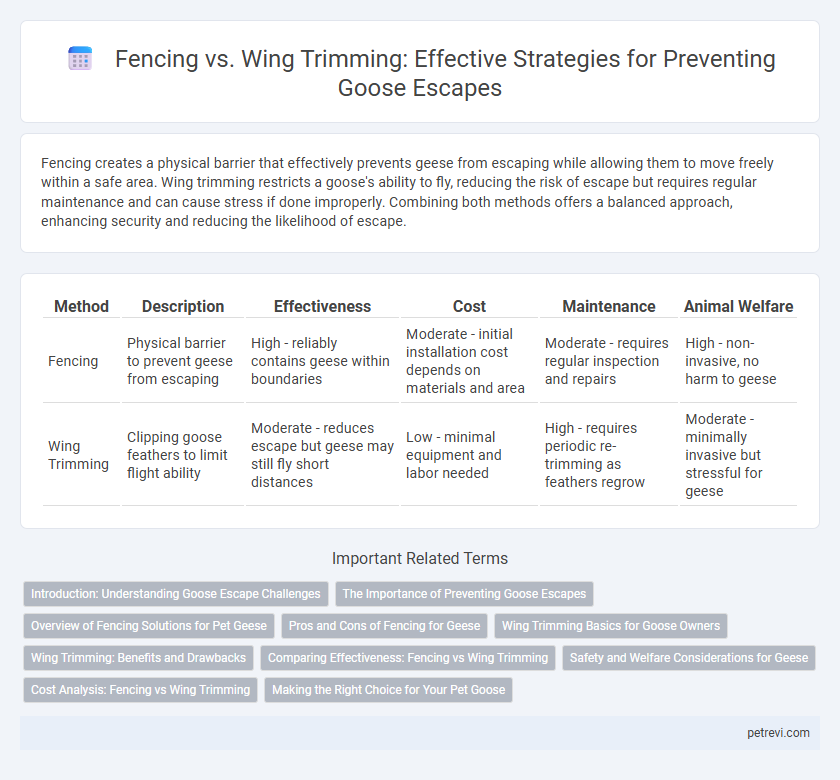Fencing creates a physical barrier that effectively prevents geese from escaping while allowing them to move freely within a safe area. Wing trimming restricts a goose's ability to fly, reducing the risk of escape but requires regular maintenance and can cause stress if done improperly. Combining both methods offers a balanced approach, enhancing security and reducing the likelihood of escape.
Table of Comparison
| Method | Description | Effectiveness | Cost | Maintenance | Animal Welfare |
|---|---|---|---|---|---|
| Fencing | Physical barrier to prevent geese from escaping | High - reliably contains geese within boundaries | Moderate - initial installation cost depends on materials and area | Moderate - requires regular inspection and repairs | High - non-invasive, no harm to geese |
| Wing Trimming | Clipping goose feathers to limit flight ability | Moderate - reduces escape but geese may still fly short distances | Low - minimal equipment and labor needed | High - requires periodic re-trimming as feathers regrow | Moderate - minimally invasive but stressful for geese |
Introduction: Understanding Goose Escape Challenges
Goose escape prevention requires effective control methods like fencing and wing trimming to address their strong flying and walking abilities. Fencing creates physical barriers that limit mobility and contain geese within designated areas, reducing the risk of escape. Wing trimming, by partially clipping flight feathers, directly impairs their ability to fly, complementing fencing efforts for enhanced containment.
The Importance of Preventing Goose Escapes
Fencing provides a physical barrier that effectively restricts geese from leaving enclosed areas, reducing risks of loss and injury, whereas wing trimming limits flight ability but does not prevent walking escapes. Preventing goose escapes is crucial to maintaining flock safety, controlling breeding, and minimizing environmental damage caused by wandering birds. Implementing proper containment methods safeguards both the geese and surrounding ecosystems by reducing escape-related hazards.
Overview of Fencing Solutions for Pet Geese
Fencing solutions for pet geese typically involve sturdy materials like welded wire or electric fences to create secure boundaries that prevent escape while allowing visibility and airflow. Ideal fence heights range from 4 to 6 feet, ensuring geese cannot easily fly over or walk under barriers designed with buried edges or skirts to deter digging. Proper installation and regular maintenance of fencing offer reliable containment, minimizing the need for frequent wing trimming and promoting overall goose safety.
Pros and Cons of Fencing for Geese
Fencing provides a physical barrier that effectively prevents geese from escaping and protects gardens and ponds from damage, making it a reliable containment method. However, fences require ongoing maintenance to remain secure and can obstruct natural scenery, potentially disturbing wildlife movement beyond geese. The installation cost and visual impact must be weighed against its durability and efficiency in controlling geese escape.
Wing Trimming Basics for Goose Owners
Wing trimming involves selectively clipping the primary flight feathers of geese to reduce their ability to fly, which helps prevent escape without causing pain or harm. This method requires regular maintenance every 6-8 weeks, typically targeting the longest feathers on one wing to create an imbalance, ensuring the goose cannot achieve lift. Proper wing trimming allows geese to remain mobile on the ground while effectively limiting flight, offering a low-stress alternative to fencing for containment.
Wing Trimming: Benefits and Drawbacks
Wing trimming effectively reduces a goose's ability to fly, significantly minimizing escape risks on farms or private properties while maintaining overall health and mobility. This method avoids the constraints and visual impact of fencing, allowing geese to roam freely without the danger of flight escape. However, improper trimming can cause imbalance or injury, requiring skilled handling and regular maintenance to ensure bird welfare and effectiveness.
Comparing Effectiveness: Fencing vs Wing Trimming
Fencing provides a physical barrier that effectively prevents geese from escaping outdoor enclosures by restricting movement, making it a reliable method for escape prevention. Wing trimming limits a goose's ability to fly but does not stop them from waddling or swimming away, reducing escape likelihood but not fully preventing it. Combining fencing with wing trimming enhances overall containment by addressing both flight and ground mobility.
Safety and Welfare Considerations for Geese
Fencing provides a physical barrier that effectively prevents geese from escaping while ensuring their safety by eliminating risks associated with wing damage or infection. Wing trimming, though limiting flight, requires careful execution to avoid pain or blood loss, and must be repeated regularly to maintain effectiveness. Prioritizing animal welfare means choosing methods that minimize stress and injury, with fencing often being the safer, more humane option for long-term management.
Cost Analysis: Fencing vs Wing Trimming
Fencing requires an initial investment in materials and installation, ranging from $10 to $30 per linear foot, with minimal ongoing maintenance costs. Wing trimming involves periodic labor costs averaging $15 to $25 per bird every 6 to 12 months but has lower upfront expenses compared to fencing. Over time, fencing proves more cost-effective for large flocks due to durability, while wing trimming offers flexibility and lower short-term costs for smaller groups.
Making the Right Choice for Your Pet Goose
Fencing provides a reliable physical barrier to prevent geese from escaping, offering long-term security and protection from predators. Wing trimming limits flight capabilities but requires regular maintenance and does not address ground-level escapes or intruders. Choosing between fencing and wing trimming depends on your goose's environment, lifestyle, and safety needs, with fencing often being the more effective and humane option.
Fencing vs Wing Trimming for Goose Escape Prevention Infographic

 petrevi.com
petrevi.com